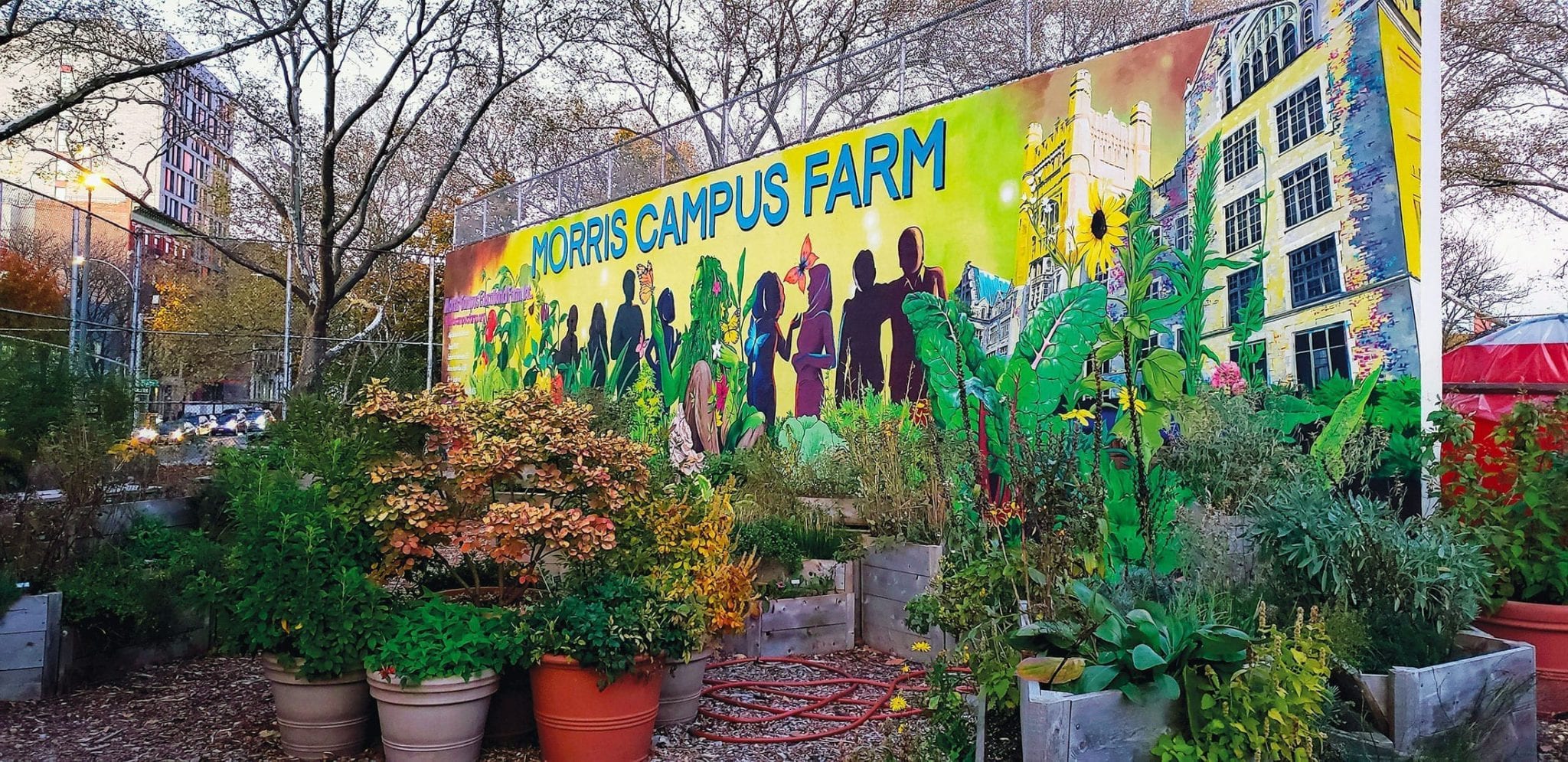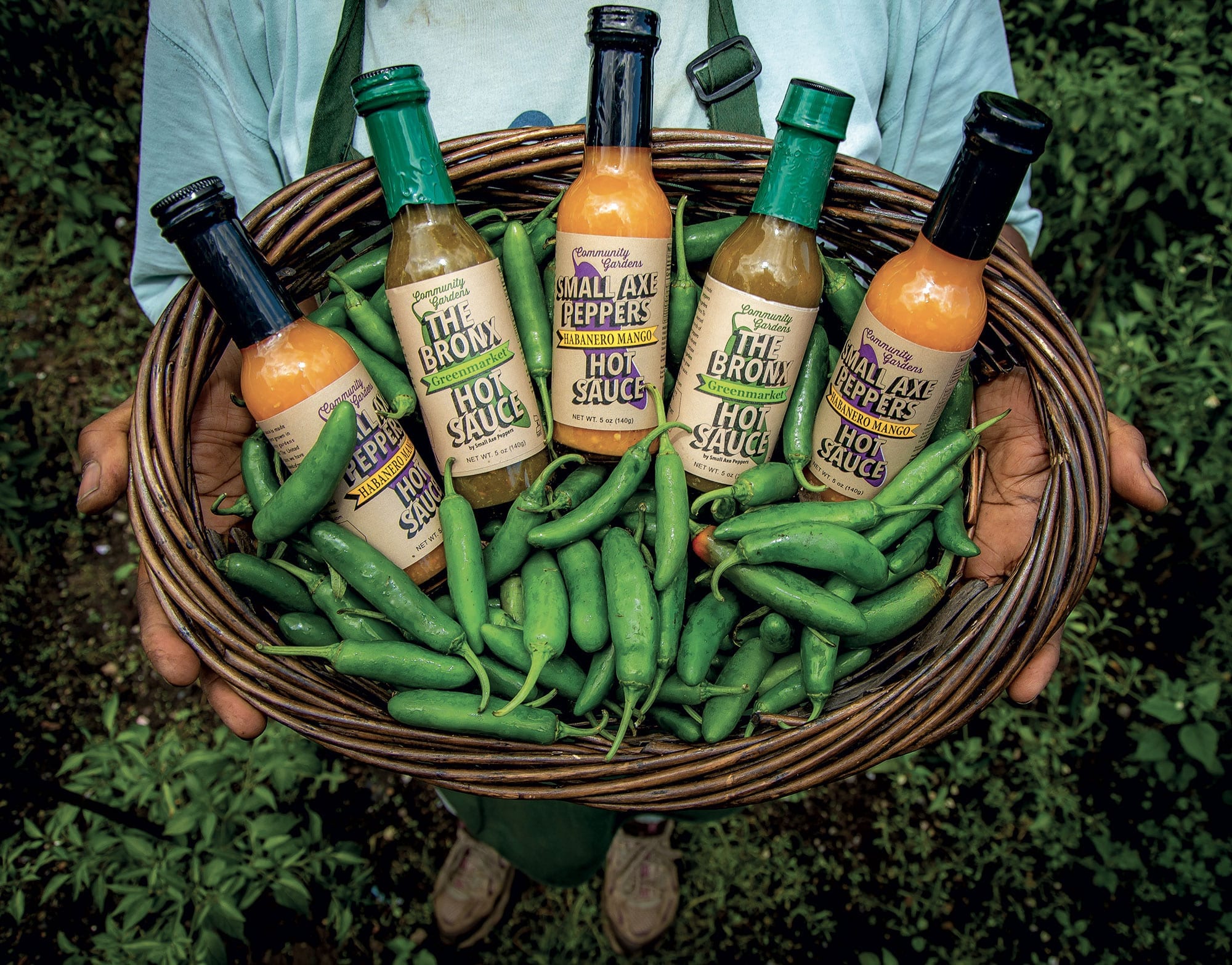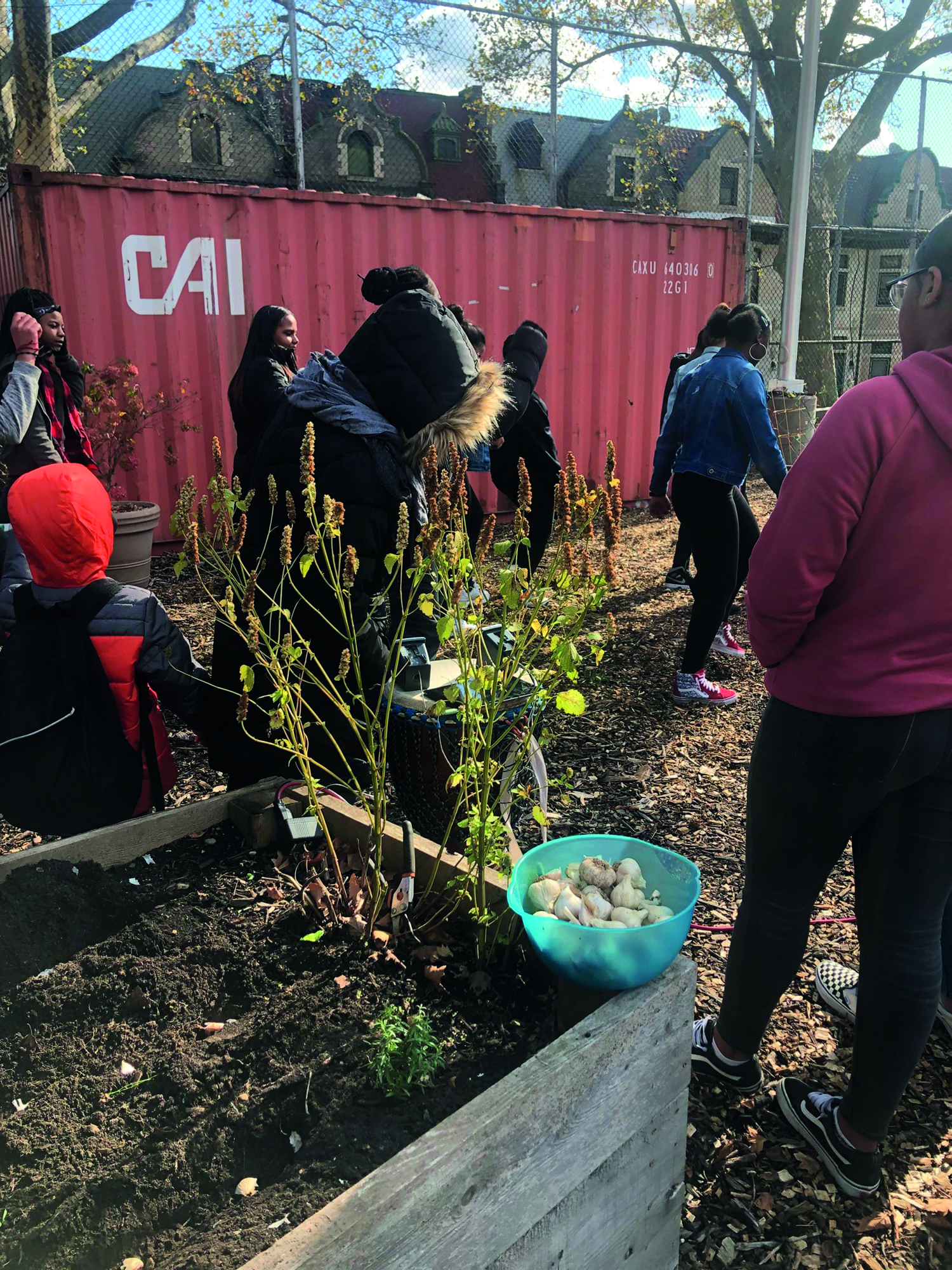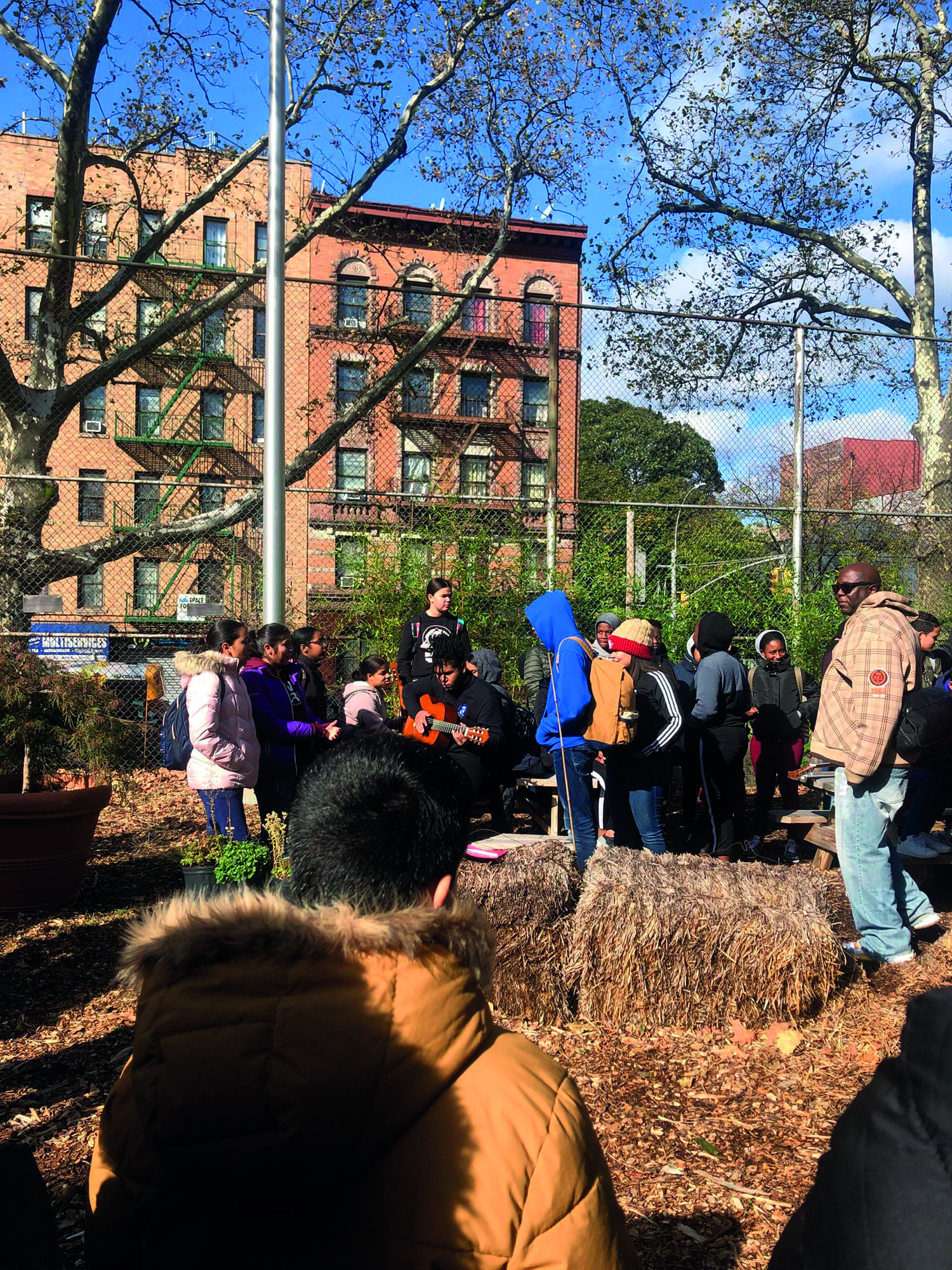History and Hustle: Urban Agriculture in the Bronx
A small, youth-led urban farm offers insights into the renaissance of urban agriculture in one of New York City’s most food insecure and impoverished neighborhoods.
On a bright but chilly Friday in the first week of November, students, teachers and school administrators gather to celebrate the Morris Campus Educational Farm’s second annual harvest festival. The farm’s compact 14,000-square foot expanse is dotted with plant beds, a half-done greenhouse and an herb garden still in bloom thanks to New York’s unusually warm fall.
Tables laden with small portions of food are lined up next to the farm’s entrance. “Come on over, you gotta try some of this curried cauliflower soup!” a woman in a chef’s uniform calls to a small group of high school students, beckoning them closer to the tables.
“I don’t know about this, I usually like fast food,” says a girl as she sniffs doubtfully at the cauliflower concoction in front of her.
Growing food in community gardens became a way for people to preserve the heritage of the homes they had left while forming new ties in the homes they had chosen.
Kadeesha Williams, Chief Horticulturist, Bronx Green Up initiative
“The only thing is, your body can’t process so much fast food, and no one will see it until you’re in the emergency room,” the chef replied, without skipping a beat. With the martyred air of teenage resignation, the girl accepts a cup of soup and takes a tentative sip. “Oh,” she exclaims, “I actually like this!” Around her, her friends slowly start to shuffle forward to grab a cup for themselves.
Located in the south-west Bronx, the Morris Campus Educational Farm is part of a compound housing four public high schools. The farm was built in 2017 on what used to be a parking lot. Since then, each summer and fall, small groups of interns are chosen from each of the four schools to tend to the farm.
Last year the farm supplied almost 300 pounds of produce to the cafeteria and another 500 pounds to the community. The farm’s bounty ranges from summertime strawberries to serrano peppers that the Small Axe er Company bottles into the Bronx Hot Sauce. The farm also grows tomatoes, eggplant, okra and a plethora of other crops that provide a steady supply of healthy food options to a part of New York where residents have historically lacked both the means for and access to healthy food.

According to the New York City Hunger Report, the Bronx is New York’s “hungriest borough,” with approximately 26.3% of residents facing food insecurity – almost 290,000 people who lack consistent access to enough food for an “active, healthy life,” according to the U.S. Department of Agriculture’s definition of food insecurity. Twenty-seven percent of the population lives under the poverty line – the highest poverty rate in New York City. The Morris Campus Education Farm is located in Morrisania, whose poverty rate is even higher than the borough’s average at approximately 35%. Many small urban farms like the Morris Campus Education Farm in the Bronx are focused on providing borough residents with better access to healthy food.
Dishing up food security
At the harvest festival, a handful of the campus’ 1,600 students drop cloves of garlic into a raised bed, gently smoothing the soil over it with small rakes. By spring, the cloves will have multiplied to produce a fresh harvest of garlic bulbs. A few feet from the garlic beds, another group of students discusses the merits of cover cropping – growing crops, not for their inherent value to humans, but for the nutritional benefits they provide to soil.
“The kids weren’t really benefiting from this space being another parking lot,” states Aaron Hargrove, the farm’s business manager. “With the urban farm, a lot of the produce we grow here, we provide to the cafeterias so there can be healthier options for the kids.”

“There’s something of a food renaissance happening in the Bronx right now because people need healthier and affordable options,” exclaims Hargrove. “Part of the reason fresh produce is so expensive is because it’s coming from so many places outside New York City. If you can grow it here, you don’t have to transport it.”
The renaissance that Hargrove alludes to has been supported, in part, by the New York Botanical Garden (NYBG). The garden’s Bronx Green Up initiative, founded in 1988, has worked with over 75 community gardens, greening groups, schools and community organizations. “NYBG is a huge institution and they’re right here in the Bronx! How could they not support this movement?” declares Kadeesha Williams, the chief horticulturist at the Bronx Green Up initiative, who grew up in the Bronx herself.
The initiative provides technical assistance and training, design expertise and plant materials like compost, top soil, shrubs and seeds. The NYBG also connects donors with communities, as was the case with the Morris Campus Educational Farm, which was partly founded with a large donation from an anonymous, one-time donor.
As incongruous as the Morris Campus Educational Farm may seem against its grey and concrete surroundings in Morrisania, urban farming has been a part of New York’s cityscape since the 19th century. Today, the city has 900 food-producing community gardens, 20 community farms and 490 school gardens like the one at Morris Campus Education Farm.
“There is a lot of diversity and innovation when it comes to urban farming. The kinds of farmers can mostly be broken down into people who are farming in community gardens, rooftop farms, and people who are using technology to do indoor farming,” states Caitlin Kelmar, the Legislative Director for Councilman Rafael Espinal from the 37th District of New York.
However, it is rare for small-scale, community farms to have access to the kind of advanced technology that drives more upscale urban farming in other parts of New York City. In the Bronx, the borough’s rich urban farming and community gardening tradition is rooted in its diversity.
Almost 37% of Bronx residents are immigrants, many of them bringing a tradition of growing their own food with them when they settle here. “My family came from South Carolina and lived around a lot of farmland. They wanted to bring some of that with them to New York,” states Williams. “My grandfather and my father were gardening in the backyard of our building. There was always some aspect of urban agriculture in my life.”
According to Williams, many people living in her community were not home-owners and could not grow food in their backyards. Over time, growing food in community gardens became a way for people to preserve the heritage of the homes they had left while forming new ties in the homes they had chosen. “I know that connecting with the earth is something innate in us. I know this because when we do, we feel grounded,” she states.

On the Morris Campus Educational Farm, many students who intern at the farm do so because they grew up in households that cultivated their own food, either out of tradition, necessity or both. Near the beds being planted with garlic, a young girl in a hijab softly tells her classmates how she and her mother would grow okra in their backyard. Except they called it ‘lady’s finger,’ as was common in their native country Bangladesh.
Finding the right fix
Despite the growth of urban farming in the Bronx, experts caution that it is far from being a panacea for the borough’s food insecurity. “I think we’d be kidding ourselves if we didn’t address the socio-economic, systemic problems. It’s not just about making more food. It’s about who gets access to that food,” says Williams.
Some of the systemic problems that Williams and others identify stem from lack of legislative support urban farmers receive. “Community garden farmers are really tied to their neighborhoods, but typically produce food at a much smaller scale. Their biggest challenge tends to be finding a way to legally operate, since there’s not a lot of rules on the books, different inspectors may come to different decisions about what is and isn’t allowed,” writes Kelmar.


Councilman Espinal has said he hopes to change that by creating an Office of Urban Agriculture in New York. “Urban farming isn’t a new concept and is something a lot of New Yorkers have been doing for generations. But nothing in our zoning reflects the need to expand this industry,” Espinal’s Legislative Director Kelmar states. “Right now, all that exists are rules that hurt the farmers, not ones that support them. When it comes to urban agriculture we want to make sure that farmers have a seat at the table, but we also have to make sure there is even a table to have a seat at.”
Espinal has been pushing for legislation that will force the Department of City Planning to amend city-wide zoning codes that restrict how urban farmers can use available land in the city.
Deliana Rosario, 16, is in the 11th grade at the School for Excellence, one of the four schools on the Morris Campus. She has been working on the farm since she was in the ninth grade and has developed an interest in understanding where the food she eats comes from. “After I ate the tomatoes we grew here, I realized that tomatoes are not supposed to have that waxy feeling that the tomatoes from the supermarket generally have.”
Rosario’s story resonated with Williams. “That’s an experience I see with almost every single group I work with. I love that they enjoy things that they all say they hate when they eat it fresh,” she says. “That’s the thing about food, once you have something really good, it is really hard to go back to eating a lower quality version.”